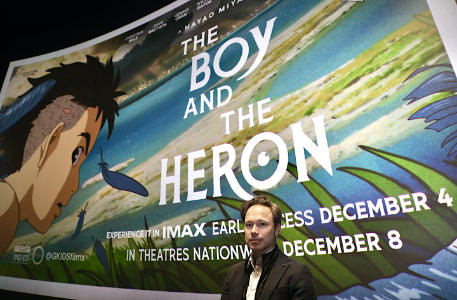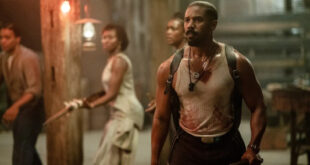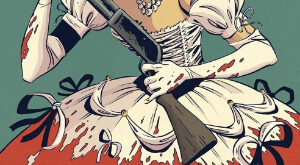
The Boy and the Heron, Hayao Miyazaki’s latest animated masterpiece, debuted its English-language version last weekend in theaters across America featuring a stellar team of actors spearheaded by Robert Pattinson, Christian Bale, Karen Fukuhara, Mark Hamill, Florence Pugh, Willem Dafoe, Dave Bautista and Tony Revolori.
And behind every great team, there is always an equally integral person at the helm. For The Boy and the Heron, that leader was acclaimed casting/dialogue director Michael Sinterniklaas.
Born in France and raised in London, Lucerne and, ultimately the United States, Sinterniklaas has made his mark on the animation and anime industry as both an actor and a dialogue/voice director. American animation fans will quickly recognize Sinterniklaas for his performances as Dean Venture of The Venture Bros. and Leonardo in the Teenage Mutant Ninja Turtles (2003), while anime fans have seen his name flash across the screen as the man responsible for steering English-language actors through the intricacies of dubbing characters in a bevy of popular anime films, including numerous productions for GKIDS films. Among his many successful dub directions are films like Your Name, My Life as a Zucchini, Batman Ninja and Mirai. He also was responsible for directing the Star Wars: Visions, LEGO Monkie Kid and Agent Elvis television series.
After less than one week in domestic theaters, The Boy and the Heron is garnering acclaim and attendance at an admirable pace. The film topped the domestic box office this past weekend, and has already received “Best Animated Film” awards and nominations from a growing swath of critics’ associations and film festivals across the world, including two Golden Globe nominations as well as a Critics Choice nomination for Best Animated Feature.
For The Boy and the Heron, Sinterniklaas – who says working on a Miyazaki film is the highpoint of his career – set one standard for the dub direction: honor Miyazaki’s legendary imagination with an equally unparalleled set of performances from an absolutely star-studded cast. Both he and the cast believe they’ve fulfilled that mission, and the praise of critics and audiences alike has justified that belief.
“This was not your typical dub, as we are all so deeply respectful of the film and its creator, especially as we initially believed this would be Miyazaki’s final film,” Sinterniklaas says. “We were adamant about honoring Miyazaki’s visuals with equally sensitive and grounded performances. The adaptation needed to be both approved by Studio Ghibli and match lip-flap/synch, while dialing in specific circumstances to heighten the emotional connection.”
While the task was monumental, Sinterniklaas had the experience – and chose an experienced, enthusiastic cast – to rise to the occasion. Part of the recording process was finding each actor’s core drive and channel that into the character, sometimes beyond the actors’ own preconceived expectations.
“The magic trick is figuring out the actor’s love language and inspiring their imagination,” Sinterniklaas says. “It’s a very collaborative process. Some actors come into the booth with a clear sense of their character, while others need to be given some initial ideas. Everyone’s process is different. My job isn’t to tell them how to do it, but to know the piece and be a north star for the actor, providing an opinion and an aesthetic that inspires them on their terms. And then the collaboration really begins.”
The cast, which also includes such notables as Gemma Chan, Keone Young, Debi Derryberry, Andrew Kishino, Mamoudou Athie and Dan Stevens (and more), recognized the importance of the job, and were all honored to be part of the majesty of a Miyazaki film. Many have stated their lifelong admiration for Miyazaki and his wealth of amazing films.
“Everyone was so generous, and very humbled to be part of this project,” Sinterniklaas adds. “This is such a Rorschach Test of a movie – it means something different to everyone. There’s so much mysticism within, as Miyazaki speaks so fluently from his sunconscious.”
Finding the voices for each of the quirky, unique characters was one piece of the equation. Additionally, there was the casting of at least one key actor to play roles that were far from their wheelhouse, leading to some true surprises in the recording process.
“Some of the actors had to find a few different voices – particularly Robert (Pattinson) and Florence (Pugh) – and both of their abilities to transform were startling,” Sinterniklaas says. “Willem (Dafoe) would do whole runs of his entire monologue, which is kind of unheard of. The versatility employed by this cast was truly impressive.
“Robert was the wild card, because we knew he will go hard and go far to capture a role, but nothing in his previous body of work was anywhere close to this role. As we developed his voice for the lead character, we realized nobody would believe it’s Robert Pattinson – but he came into the booth with that voice in mind. He’d seen the movie, and really put a lot of thought into it. He actually made some voice recordings on his phone that he played for us when he arrived, and it was genius – all I had to do was define for him the two faces of the Heron. Like the rest of us, Robert took this film very personally.”
Fukuhara also came to the studio with a preconceived notion of her character’s voice, but Sinterniklaas steered her in a decidedly different, liberating direction.
“I came to The Boy and the Heron recording booth, prepped and ready to deliver an exact English dub version of the Japanese voice artist, Aimyon,” says Fukuhara (The Boys, Suicide Squad). “I somehow stubbornly thought that was how dubbing should be – to be as close as possible to the original cast, because, well, I thought ‘there must be a reason the creators wanted this type of voice in the first place.’ I put Lady Himi’s voice in the same vocal range, with similar intonations and expressions, all because I believed that was what I was being hired to do. Luckily, I had Michael as our director. After some time in the booth, Michael told me that I didn’t have to follow the original voice so much – that I could have more fun with it. He gave me permission to be more free, more colorful. With his guidance, I think we were able to achieve a Himi that is both strong, yet vulnerable; a character with depth; and most of all, a character that carries the emotional weight that helps the audience believe she can lead Mahito to his conclusions at the end of the film.”
And as impressed as Sinterniklaas is with his cast, that cast is equally appreciative of his guidance, advice, subtle tips and overall direction.
“Although I have only recorded at home since before the pandemic, I made a point of going to the studio for The Boy and the Heron,” explained Mark Hamill (Star Wars franchise). “I’m a great admirer of Miyazaki, having been a voice in Castle in the Sky, and was honored to be asked to be a part of his latest. I want to thank Michael, not only for thinking of me for the film, but for his expert guidance & easy manner during the session. I’m thrilled at the success of the film, both critically & financially, which it so richly deserves.”
“When Michael and I worked together on Star Wars: Visions, I vividly remember how I could sense his enthusiasm in directing even through the virtual zoom recording,” says Fukuhara. “Michael’s energy is electric, even through a screen. When a director shows how much he/she is digging what you’re bringing to the table, you instantly feel like you can play with different versions of the scene. I think Michael’s acceptance/treatment of his performers allows room for creativity to soar.”
“As a fan of anime and anime dubs, I’d known Michael’s name for some time as he’s been the voice of quite a few characters in productions that I love – so it was an honor, and quite unexpected, to get the call,” remarks Anthony Revolori (Spider-Man: No Way Home, The Grand Budapest Hotel). “Michael gave lots of notes as he really strives to pack more emotionality into the performances than most dubs. But then we just started trying lots of different voices and approaches – militaristic, funny, serious, even having the voices do that cracking that happens when you go through puberty. He had a clear vision of what needed to happen, but he didn’t try to force any ideas on me. Rather, he guided me while letting me have freedom to explore, helping to make me confident in every take, whether he used it or not.
“Michael did an incredible job. What I loved was that, while in most cases you can recognize the actor (by their voice), he never let that overshadow the impact of the movie. There’s a brilliance to that ability. This has been one of the best voice acting experiences of my life, and that is in no small part due to Michael.”
Sinterniklaas goes beyond directing and acting – he’s also the owner of NYAV Post, a bi-coastal, full-service recording center with facilities in both Los Angeles and New York that currently include four full theatrical recording studios (plus one print master stage) with capacity for all the essentials: recording, editing, mixing, folly, scoring, sound design and more. Among the dozens/hundreds of productions to utilize the studio, four films dubbed via NYAV Post have received Academy Award nominations: A Cat in Paris, Ernest and Celestine, My LIfe As A Zucchini and Mirai (which also earned a Golden Globe nomination and won ASIFA’s Best Animated Feature award). Among other NYAV Post associations are the films Belle, Promare, A Silent Voice and The First Slam Dunk, TV series like LEGO Monkey Kid and Star Wars: Visions, and video games like Triple A Games’ heralded Just Cause 3, Fallout: New Vegas, Borderlands 3 (with Ice-T), NCIS (with the late David McCallum), Brothers in Arms and the upcoming Pacific Drive.
NYAV Post sets itself apart from other boutique studios with their added-value services like writing, production management, signatory service and the boundless creative expertise from Sinterniklaas and his award-winning staff.
“As we are able to accommodate both original and dubbed productions, our philosophy has been to concentrate on being a ‘performance first’-driven boutique house,” Sinterniklaas explains. “Our approach draws from classical fundamentals to serve each piece with the most grounded and specific performances, ensuring each piece’s unique needs are met. Owning the production facility means we are able to implement our own workflows to make that happen.”
 Premier Pop C Pop Culture News – Movies, Comics, Television, Books, Toys, Games, and More
Premier Pop C Pop Culture News – Movies, Comics, Television, Books, Toys, Games, and More 
